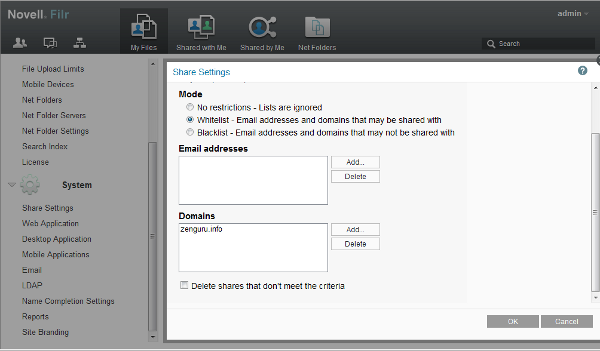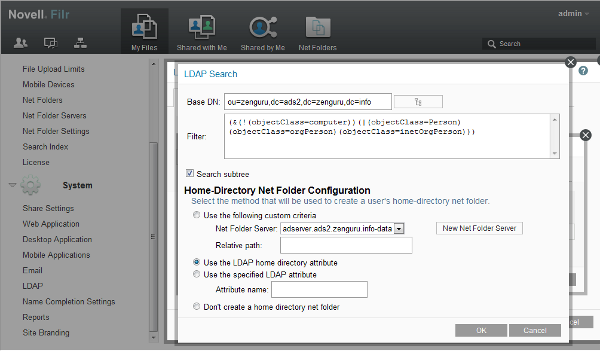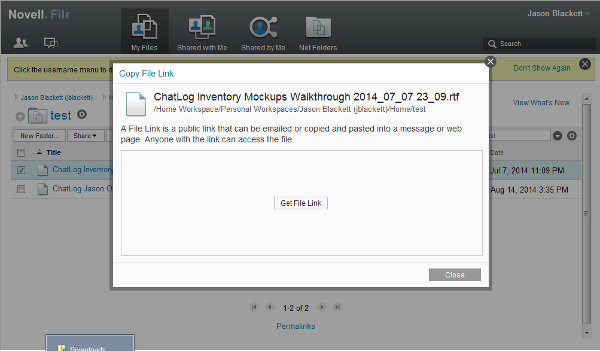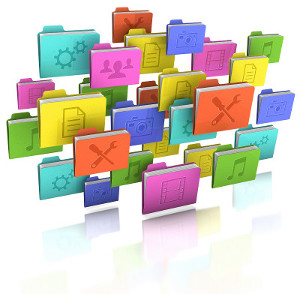On October 2, 2014 Novell released the next major version of its Filr solution. If you aren’t familiar with Filr, let’s recap just briefly.
Novell Filr is a solution that allows you to quickly and easily make some or all of the files that are stored on your existing file servers – Windows (CIFS) or OES (NCP) – available to your end users from their mobile device, traditional Windows or OS-X, or via web browser. Filr provides the ability for uses to comment about files, share files with other users inside or outside the company. Effectively what Filr does is open up access to the files in your data center so that users can get work done no matter where they are, when it is or what device they happen to be using.
Filr 1.1 is an evolutionary release that provides new capabilities in the following categories.
Performance and Scale
A significant portion of the development and testing for Filr 1.1 was intent to improve the scalability of the Filr system and ensure that it will run well in the enterprise. Some of the key new performance improvements include:
- Metadata synchronisation performance has improved by a factor of ten. If you know how Filr works you know how important this is. Filr uses a metadata cache that it builds from the file server to make files available to the users. By multithreading the metadata synchronisation capabilities, modifying the approach so that only directories have to be synced, and allowing this activity to be performed by dedicated servers it is possible to make huge amounts of data accessible on netfolders in a fraction of the time it took in Filr 1.0 and 1.0.1.
- LDAP synchronisation improvements resulting in a three to ten times decrease in the amount of time it takes to synchronise LDAP users and groups from large eDirectory and Active Directory trees. Between the metadata sync and the LDAP sync improvements this means users can start accessing the Filr system and the back-end data it exposes as much as ten time sooner.
- Extensive performance testing was done and indicates that with the changes made Filr 1.1 should support at least 500 users per virtual appliance and possibly significantly more depending on the way Filr is used in your environment. For more extensive information about the testing performed against 1.1 refer to the Filr 1.1 Scale and Performance whitepapers on the documentation site. An updated version of the Best Practices guide is also being created that will include information about how you can optimise the Filr system based on your requirements.
Security
Another key focus in the Filr 1.1 release is around security. The key security related changes include:
- To enhance the sharing security, administrators now have the ability to add email domain based whitelisting and blacklisting for external sharing. This allows the administrator to limit the external users that end users can share data with. For instance, you can specify that external users may only share with email users that have a domain of zenguru.info. This would restrict sharing with external users with email addresses that end with @zenguru.info.

- The ability to view all mobile devices that have the Filr client installed and wipe them from the Filr console in the event that they are lost or stolen. You can also control what applications Filr will allow its data to be opened in as well as the ability to copy/paste data from the Filr application. Finally you can restrict access to Filr data if the device is jailbroken or rooted. In previous versions of Filr all of these capablities required an MDM solution such as ZENworks Mobile Management or MobileIron.
- The administrator can now control whether end users are allowed to access the Filr end user web interface and if files can be downloaded from the web. When this capability is restricted the user may only be able to use the desktop or mobile clients, or may be allowed to use the web client but not download files.
Administration
Filr 1.1 also provides a number of enhancements to the administration console to help simplify the management of the system. These include:
- Significant changes to the LDAP server configuration that makes it easy for the administrator to add server definitions. This includes the ability to browse for containers when setting up groups and containers; the ability to customise the network path for home folders using either the home directory variable in the LDAP server or a custom path using variables; and support for groups of the same name in multiple containers in the LDAP server. (Figure 2)
- The administrator can now grant access to netfolders by LDAP organisational unit as well as user and group. This feature is currently supported only on eDirectory.
- A simple interface for applying Filr patches to the Filr appliances has been added. This allows Novell to release patch files that can be uploaded to the Filr server and automatically applied.

End User Capabilities
Finally, no release of Filr would be complete without something for the end user. This version includes the following:
- Link based sharing of files. This feature allows end users to share files with a user or set of users by simply sending them a URL. This was a commonly requested feature from users of other sharing systems such as Dropbox and OneDrive. This makes it easy to post links on social media tools or other web sites as a means of sharing files. Link based sharing can be done through either the Filr client or the web client. (Figure 3).
- The web interface now provides the ability to download multiple files and/or directories as a zip file.

Summary
We hope you’ll find the latest version of Filr a great addition to your IT infrastructure and encourage you to try it today by downloading it from our website today. You can also check-out the Filr 1.1 documentation for a full list of the new features of 1.1.
Filr is a great example of Novell products that let you say “yes” to the demands of your end users and business owners, while at the same time saying “yes” to the security demands of today’s security conscious enterprise -- and remember if you’re an OES customer with active maintenance, then you are already entitled to Filr.

